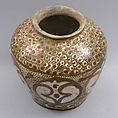Luster Jar with Medallions and Peacock-Eye Pattern
Not on view
Embodying different technical and stylistic variations that European and North American collectors appreciated in the early twentieth century, this jar shows how in the ninth century, Iraqi potters used new technologies to respond to coeval poetics of wonder.
The sheen of these vessels' luster-painted surface (obtained with metallic pigments) would have inevitably changed according to the intensity and direction of the light source while holding and moving them, creating an unpredictable and varied experience for the beholder. Such shifts of color and iridescence, termed abū qalamūn in contemporary Arabic sources, respond to expectations of wonderment (‘ajab) found in written descriptions of encountering natural or human-made marvels. The so-called peacock-eye pattern of the jar’s shoulder and base would have lent itself well to such aesthetics.
Due to rights restrictions, this image cannot be enlarged, viewed at full screen, or downloaded.
This artwork is meant to be viewed from right to left. Scroll left to view more.



